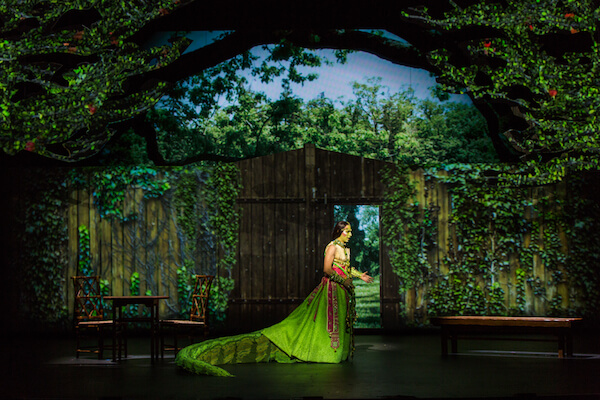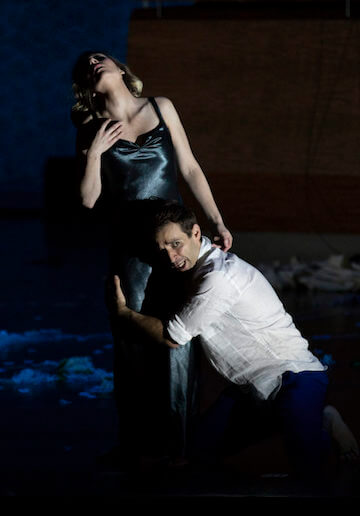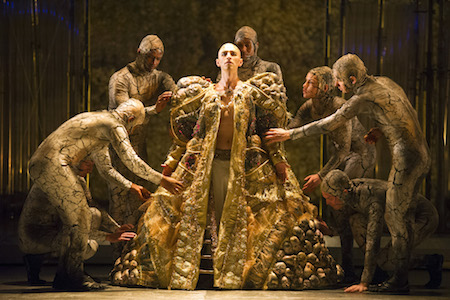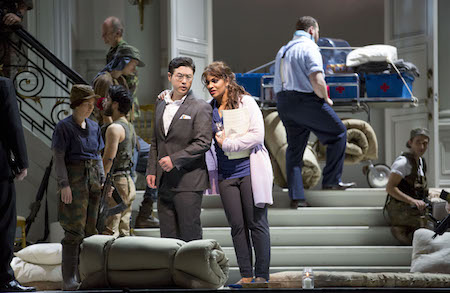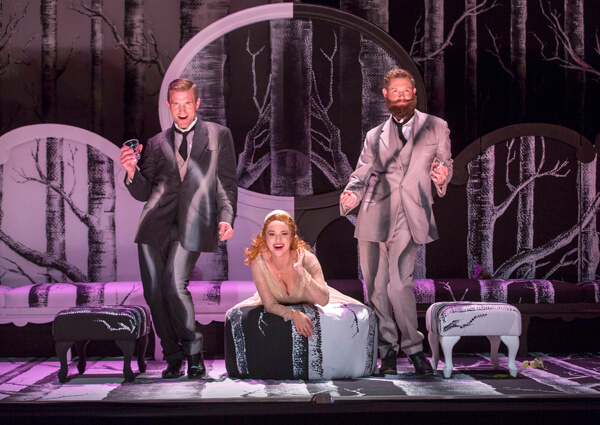Anthony Roth Costanzo in Paola Prestini’s “Gilgamesh,” from the “Ouroboros Trilogy” performed at Emerson College’s Cutler Majestic Theatre in Boston. | JAMES DANIEL
Cerise Lim Jacobs, the intrepid and artistically ambitious muscle behind the long-in-gestation “Ouroboros Trilogy” just unveiled in Boston, has much of which to be proud. Though her texts are sporadically awkward and overly allusive, the powerful stories unfurled in them — different aspects of the Chinese legend of Madame White Snake — are intriguing and certainly fit subjects for operatic embodiment.
The three composers Lim Jacobs called upon — Zhou Long for “Madame White Snake,” premiered in 2010 by the defunct Opera Boston, plus Paola Prestini for “Gilgamesh” and Scott Wheeler for “Naga,” both given world premieres this month — all provided scores of quality notably superior to many contemporary efforts at mythologically-based opera. Teaming with visionary new opera production company diva Beth Morrison, Lim Jacobs hired a very fine cast and at least two outstanding conductors (Julian Wachner for the Prestini and Carolyn Kuan for the Wheeler).
They also hired — and not without reason, based on a more than solid track record — Michael Counts as director and production designer. Counts’ remarkable success in supplying a visually memorable and clearly fantastically expensive design unfortunately undermined the basic storytelling a director must provide, especially with rather recondite narratives performed in an order that shifted from one series of performances to the next.
Flashy staging impedes substantive new operatic trilogy in Boston
Emerson College’s excellent Broadway-sized Cutler Majestic Theatre, a good venue for clarity of textual enunciation, hosted the world premiere showings of the full trilogy on September 10. Each work had a stand-alone performance over the week that followed, which was surely merited by their roughly 100 minutes per. I heard the third series of performances — a second marathon on September 17 in the somewhat random order of “Gilgamesh” (11 a.m.), “Naga” (3 p.m.), and “Madame White Snake” (7:30).
Wheeler’s is perhaps the more sophisticated and technically interesting of the two new scores, but Prestini’s, more “Nouvelle Romantic” in places, packed more emotional punch. Both operas were impeded by Ling Jacobs having introduced prolix excerpts from anachronistic Biblical language — how could characters right after the Flood quote the Song of Solomon? — and even, distractingly, from Shakespeare, both “King Lear” and “The Tempest.” These should be rethought in future iterations of the project — which are well warranted.
Counts provided an imaginatively imaged “Mosè in Egitto” for City Opera in 2013: the projections there suited that work’s oratorical style. Here, he overwhelmed the characters’ interactions — only sometimes supernatural in nature — with lavish (and often very beautiful) nature videos and projected slides by S. Katy Tucker.
Worse, the elements were often oversized and misused theatrically: White Snake, supposedly imprisoned for decades in a bowl, nimbly stepped out of it to sing. Huge projections of Prestini's character Ming (White Snake’s abandoned son) and Wheeler’s Monk (essentially the same figure in the myth, who loses a wife and a much-awaited newborn to his mother’s legacy) benefitted from the handsome faces of, respectively, Christopher Burchett (dramatically committed but often shouty) and Matthew Worth (who has become an excellent, even-voiced interpreter of contemporary music). But they overwhelmed the stage needlessly.
Even more distracting were the videos of a faintly grinning white snake, whether flying through the universe or leaving a garden bestowing a touch of unwelcome Saturday morning comedy.
And, there seemed to be virtually no Personenregie; characters stood in line and sang facing the audience, and it was often unclear to what extent they were meant to be aware of one another’s presence. Unless we’re headed for some Gordon Craig future in which design trumps everything, even mythic stories need well elucidated human underpinnings.
The character Gilgamesh enters Prestini’s opera via a dream by its protagonist, Ming. Ming’s expectant wife Ku got a lovely, rounded performance from Heather Buck, a lithe and impactful actress with an uncommonly beautiful soprano for the high-lying and testing repertory she serves. By comparison, the worthy Hila Plitmann, who sang this incarnation of White Snake, sounded less accurate and more typically a “new music practitioner” as to timbre.
Xiao Qing, an androgynous green snake once a man in love with White Snake (whom he now serves) found a fantastic embodiment in the first two operas by countertenor Anthony Roth Costanzo. Working an incredibly ornate costume (by Zane Pihlstrom, who had a field day throughout) with a breathtaking serpentine train, Costanzo, who moves with uncommon grace, remained almost continually in spellbinding circular motion. Prestini’s score called upon baritonal resonance I hadn’t heard before from Costanzo, also supplying him with legato sections to sculpt. Everything he did and sang served to build a concrete and memorable character.
Wachner nailed the required instrumental balance and clarity.
Worth largely carried “Naga,” along with the absolutely spectacular Stacey Tappan as Madame White Snake. Why this wonderful coloratura, with a full, penetrating, steady, and lovely voice capable of executing seemingly any technical feat, sings mainly in Los Angeles I don’t know. We need her in New York! Sandra Piques Eddy was moving as the Monk’s pregnant wife; sounding healthy in the middle, she encountered consistent trouble on top notes. David Salsbery Fry gave a fine, resonant performance as the Master whom the Monk apprentices himself to and eventually kills for White Snake’s sake.
Wheeler’s music has many interesting parallel motions — sometimes occasioned by too-frequent repetitions in the libretto — and reaches an exciting climax. Kuan steered the soloists, instrumentalists, and industrious choruses (distractingly placed in side boxes, jumping up for entries) with distinction.
Three of the four creators of “Madame White Snake” returned, showing full mastery of Zhou Long’s complex idiom: high tessitura, “extended” vocal technique, and some vocal percussion effects that — combined with the deftly applied Chinese flutes and harp gave this score the most genuine-sounding flavor of Chinese opera. As the mortal lover Xu Xian, fearless high tenor Peter Tantsits wielded an expressive timbre grown in warmth and scope since 2010. Chinese bass Dong-Jian Gong had improved his diction, remaining powerful as the Abbot who challenges White Snake’s magic.
Michael Maniaci’s Xiao Qing was less serpentine and entrancing a presence than Costanzo; positioned on a boat with his mistress at the staging’s start and finish, Maniaci evoked “Frau ohne Schatten”’s sorrowful Amme — but his very different, more purely instrumental voice remained fascinating and he caught the pathos of this ambivalently transgender eternal suitor.
Succeeding 2010’s ultra-glam Ying Huang, Susannah Biller did lovely work as White Snake, with fresh, liquid timbre and touching expressivity.
Unfortunately Lan Hui’s uneven conducting, sometimes drowning the singers, was hardly an improvement on 2010’s Gil Rose. The Boston Children’s Chorus — eloquent and committed throughout — had particularly rich material here.
David Shengold (shengold@yahoo.com) writes about opera for many venues.

